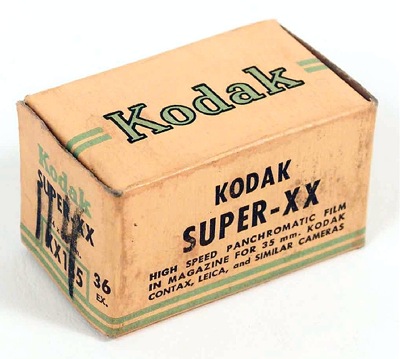 [In this five-part Guest Post, military historian Charles Herrick pursues further the questions raised by conflicts between Capa’s own account (in Slightly Out of Focus) of his D-Day return trip from the Easy Red sector of Omaha Beach to the USS Samuel Chase (APA-26), which would take him and his films back to England.
[In this five-part Guest Post, military historian Charles Herrick pursues further the questions raised by conflicts between Capa’s own account (in Slightly Out of Focus) of his D-Day return trip from the Easy Red sector of Omaha Beach to the USS Samuel Chase (APA-26), which would take him and his films back to England.
Part 4 appears below. Click here for Part 1, here for Part 2, here for Part 3, and here for Part 5. — A.D.C.]
•
Leaving Omaha Beach:
Robert Capa Aboard LCI(L)-94 (4)
•
The Missing Troops
… Fortunately, further proof that Capa landed first can be found in his own photos. If LCI(L)-94 landed first, the men it discharged should be seen in at least one of Capa’s photos. They are not.
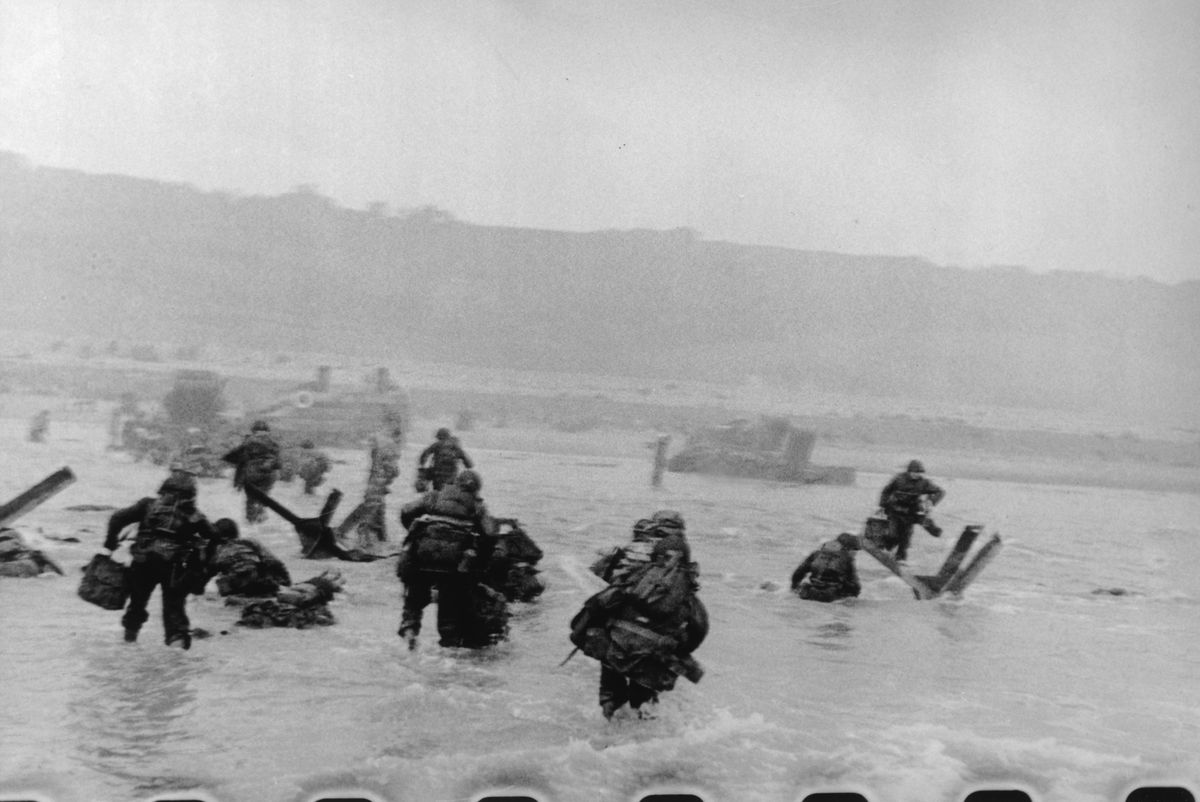
Figure 9. Capa’s negative 30, showing a view of the beach angled to the right from the bow of his LCVP.
Negative 30 (Figure 9) was shot while Capa was still on the ramp of his LCVP, and is angled to the right, towards the shoreline directly ahead of LCI(L)-94‘s initial beaching spot.
To demonstrate the close proximity of Capa’s beaching site to LCI(L)-94‘s initial beaching site, refer to Figure 10, which is a still from Ruley’s motion-picture film showing troops debarking at the LCI’s first beaching site. The LCVP in the upper left corner of the still is positioned approximately where Capa’s LCVP beached. [1]
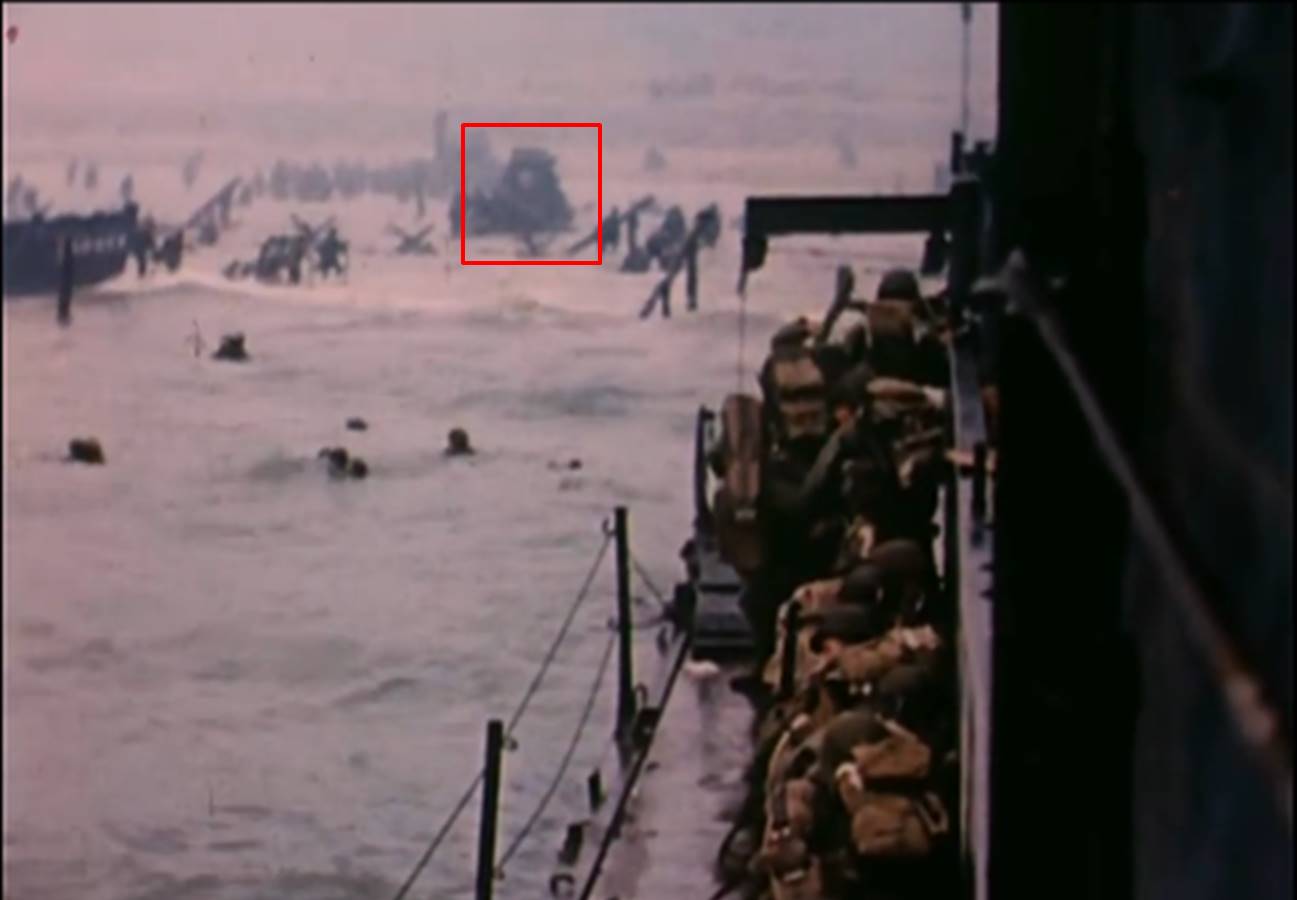
Fig. 10: David T. Ruley, Easy Red sector, Omaha Beach, USCG film, 6/6/44 (a), annotated. Red square highlights Armored Assault Vehicle #10, behind which Capa sheltered.
So the field of view in negative 30 should show at least parts of two columns of troops spreading out as they waded from the LCI’s two boarding ramps toward the shingle embankment, as well as a number of troops taking shelter at that embankment. That is what we see directly to Capa’s front, as the troops from his LCVP and other craft made their way to shore. But instead of the 100 troops landed by the LCI, all we see are a few dark images, and only at the embankment — not nearly enough to represent the number of debarked troops.
•
To underscore this point, just 5-6 minutes elapsed between the time Capa shot negative 30 and the time he took the “Face in the Surf” photo with LCI(L)-94 in the background. The LCI could not have retracted to where we see it in the “Face in the Surf” photo unless it had already debarked almost all of those 100 men by the time Capa snapped negative 30. Which means that a large number of those troops would be up and moving on the right side of negative 30. If, that is, LCI(L)-94 landed first.
You might ask how I came up with that 5-6 minute window. All we have to do is examine the tide in each of those photos. Figure 11 is a compilation of details from all of the photos Capa took during his brief stay on Easy Red. All of the Czech hedgehogs are from the same row, and many of the photos show the exact same obstacles.
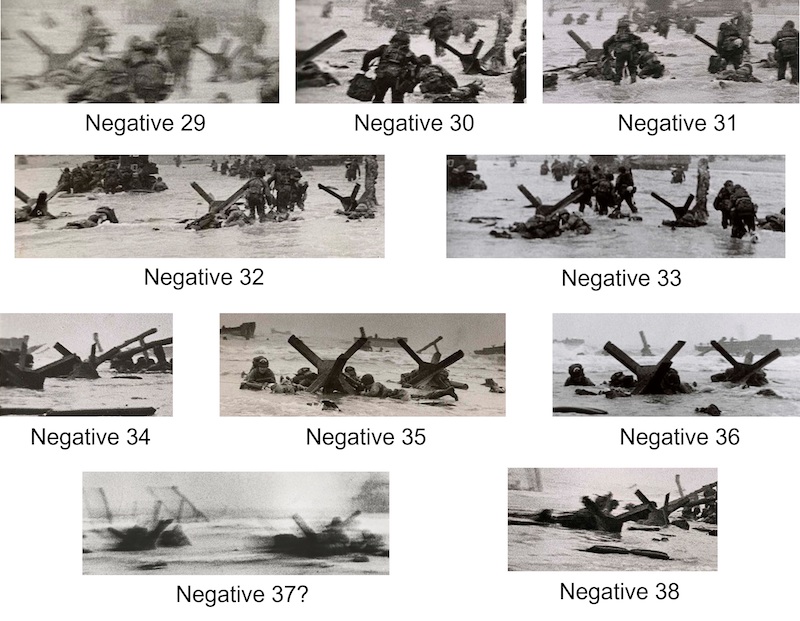
Figure 11. Details from all ten of Capa’s beach photos showing the height of the tide on the same row of Czech hedgehog obstacles.
Remarkably, there is very little variation in tide height relative to the gusset plates that join the legs of the hedgehogs together. At the lowest, the tide is just a few inches below the gusset plates; at the highest, it reaches just a few inches above the bottom of the gusset plates. This short range holds true despite the small swells that can be seen passing through these views as the tide comes in.
The critical point is that there seems to be very little in the way of a trend of rising tide between Capa’s first photo (negative 29) and his last photo (negative 38). What rise there was certainly measured much less than a foot, and seems to be on the order of 5-6 inches. (By way of providing a rough point of comparison, the GI helmets were 7 inches deep.) Let’s see what that equates to in terms of the passage of time.
•
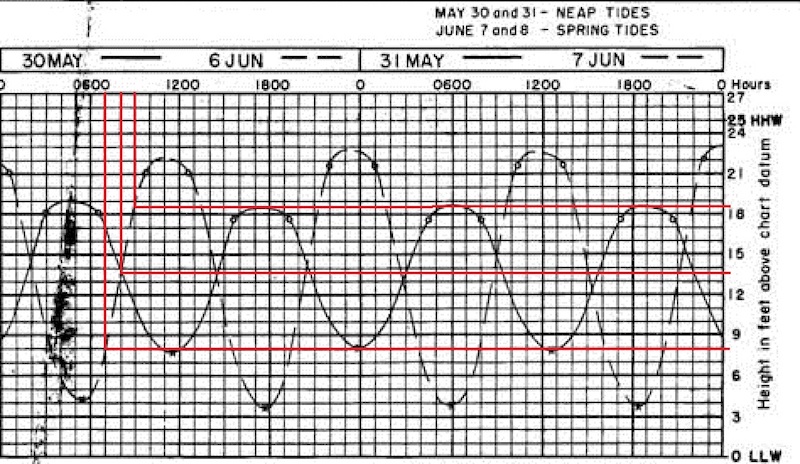
Figure 12. Detail from the Tidal Stages table printed on the reverse of the CTF 122 Omaha Beach East map prepared 21 April 1944. The dashed line shows the projected tide for 6 June 1944. The red index lines show that the tide rose about 10 ½ feet between 0700 and 0900 hours, or about 63 inches an hour.
Turning to the Tidal Stages chart (Figure 12) which was printed on the reverse of the “Omaha Beach, East” invasion map, we can gain an appreciation for the rapid rise of the tide on D-Day. Between 0700 hours and 0900 hours the tide rose at a very steady rate and totaled approximately 10-1/2 feet. That comes to roughly 63 inches an hour, or about 10-1/2 inches every 10 minutes. Which tells us that from the moment Capa took his first photo from the ramp of his LCVP to his last photo on the beach, only 5-6 minutes had passed.
And, to restate my point, 5-6 minutes is not enough time for the LCI to retract that far offshore, unless the vast majority of its first 100 troops had been debarked by the time Capa took negative 30. If that were the case, then a large number of them should be visible in negative 30. But they aren’t.
With two boarding alternatives available, the cumulative evidence points to Capa boarding at the earlier opportunity, at the end of LCI(L)-94‘s initial beaching. First, the idea that he boarded just as the ship was hit is clearly ruled out by several facts, as previously discussed; having eliminated that option, the only possible alternative is boarding at the first beaching site. Second, the timelines of Capa’s LCVP and LCI(L)-94 do not allow the LCI’s arrival before Capa’s. Finally, the absence of troops from LCI(L)-94 in Capa’s initial photos indicates that the ship could not have beached before Capa landed, discharged half its troops, and still be seen retracting in the “Face in the Surf” photo.
•
At this point we should recall an interesting point about Capa’s photo-taking. Once he stepped into the surf, he seems to have completely forgotten about the battle on shore. Each and every shot was angled at least partly — if not entirely — seaward. This tells me that he was primarily looking for a means to depart, and taking photos was a secondary consideration. But more importantly, Capa’s picture-taking stopped almost immediately upon LCI(L)-94 showing up in his viewfinder. Which suggests to me that he’d seen his means of escape and was moving to get aboard. And that would mean the LCI was heading in when he saw it, not retracting.
•
What Really Happened — Maybe
I believe I have proven that Capa’s two accounts are impossible if we assume he boarded at the end of LCI(L)-94‘s second beaching. The timeline simply doesn’t allow for all he claimed he did or must have done. On the other hand, if he boarded at the end of the ship’s first beaching, virtually all the objections to his narratives are explained or mooted.
So this is what I suspect happened.
Based on the evidence of his photos, and his limited time ashore, Capa made it no farther in than to take shelter behind tank dozer #10, the spot from which he captured the “Face in the Surf” photo. Seeing that ship arrive, he quickly ceased his picture-taking.[2]
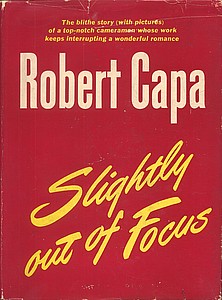
Robert Capa, “Slightly Out of Focus” (1947), cover.
Ruley and Coit Hendley both estimated that the LCI(L)-94 moved about 100 yards to its second beaching site, and Figure 9 (above, at top of post) shows this as a good estimate. At the moment Capa spotted LCI(L)-94 debarking troops at its first landing site, he was sheltering behind tank dozer #10, which, coincidentally, was located about where the LCI would make its second beaching.
In other words, Capa had about 100 yards to cover in wading from his shelter behind tank dozer #10 to reach LCI(L)-94 at its first site. This is not an unreasonable distance to cover in calf-deep surf in the time it would have taken to disembark 100 men from the LCI. And there he waited until the flow of troops down the boarding ramps stopped as the ship prepared to retract and relocate. He then boarded.
However, merely boarding the ship was no guarantee of safety, especially above decks, and we can expect that a man as badly shaken as was Capa would have sought cover below decks. To this we can add the assumption that the professional photographer in him wanted to see to his cameras and film (whether drying it or changing it), which reinforced his urge to head below decks.
•
The hatches to the troop compartments would have still been congested with men coming up on deck. The first hatch into the deck house, however, would have been free of embarked troops; conveniently, it led to a ladder down into the engine room. Capa naturally would have taken it, both for safety from small-arms fire and incoming shells and for comfort (to dry off). Whether he actually changed film or dried it or did nothing about it really doesn’t matter, and in his own accounts he confused the matter so much that it’s impossible to say.
Once he arrived in the engine room, he would have had 15 to 20 minutes to dry off in the 120-degree heat and regain his composure. Being below decks when the ship was hit, he couldn’t have been covered in kapok. These two points explain why he looked so dry and clean in Figure 6. His presence in the engine room when the ship was hit, amid the roar and vibration of the eight diesel engines, explains why he only noticed one shell hit, which seemed like nothing more than a slight shock.
After the ship had retracted the second time and the engine room had received orders to “steam” ahead, Lewis was relieved from duties in the engine room — his station during beaching operations. This meant that the ship had completed its landing and the disembarkation of its troops. This would have been the signal to Capa that the ship was turning away from the beach, making it safer to come back up from the engine room. Once on deck, he took his two “one last shot of the beach” photos.
A nearby ladder then took him up to the boat deck and the scene of the crew treating a dying crewman. If Capa did see the bloodstained captain, it was likely at this point, when Lt. Gislason felt it was safe to momentarily leave the open conning station and check on the casualties. Any blood on Gislason would have been transfer blood from contact with the casualties (rather than splatter from the detonations).
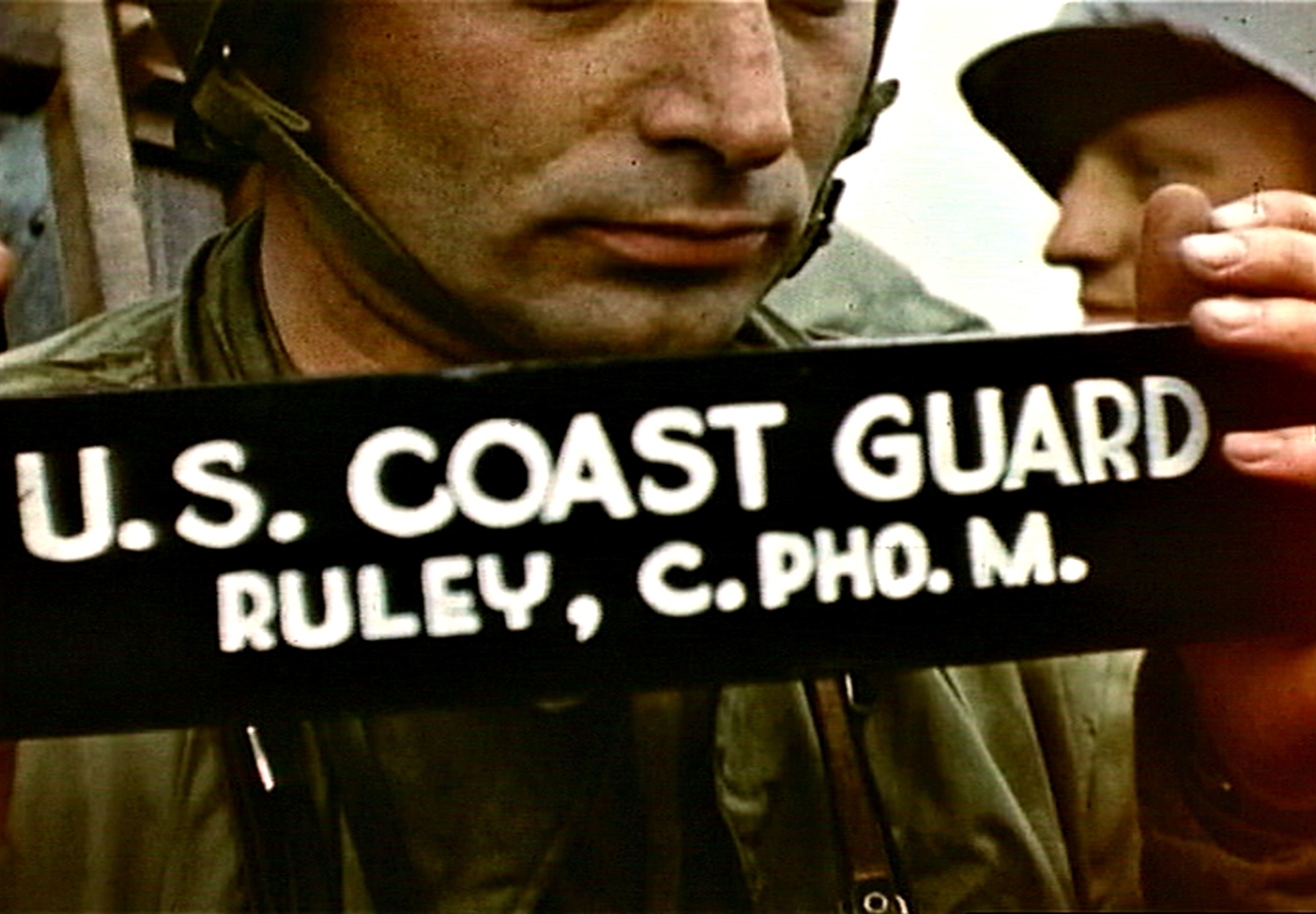
Fig. 7: Robert Capa holding cinematographer’s slate aboard LCI(L)-94, D-Day, frame from film by David T. Ruley
At some point while on the boat deck, Capa obligingly held Ruley’s slate board, as seen in the latter’s film clip. Ruley’s landing film shows that he positioned himself to film both on the boat deck and in the open conn during the beaching; when Capa arrived on the boat deck Ruley probably took him up to the conn with him. From there, the pair took their shots looking down at the crew working on the casualty. (Fig. 22) Lt. Gislason isn’t in those images, which suggests that he was back up in the conn by the time they took their shots.
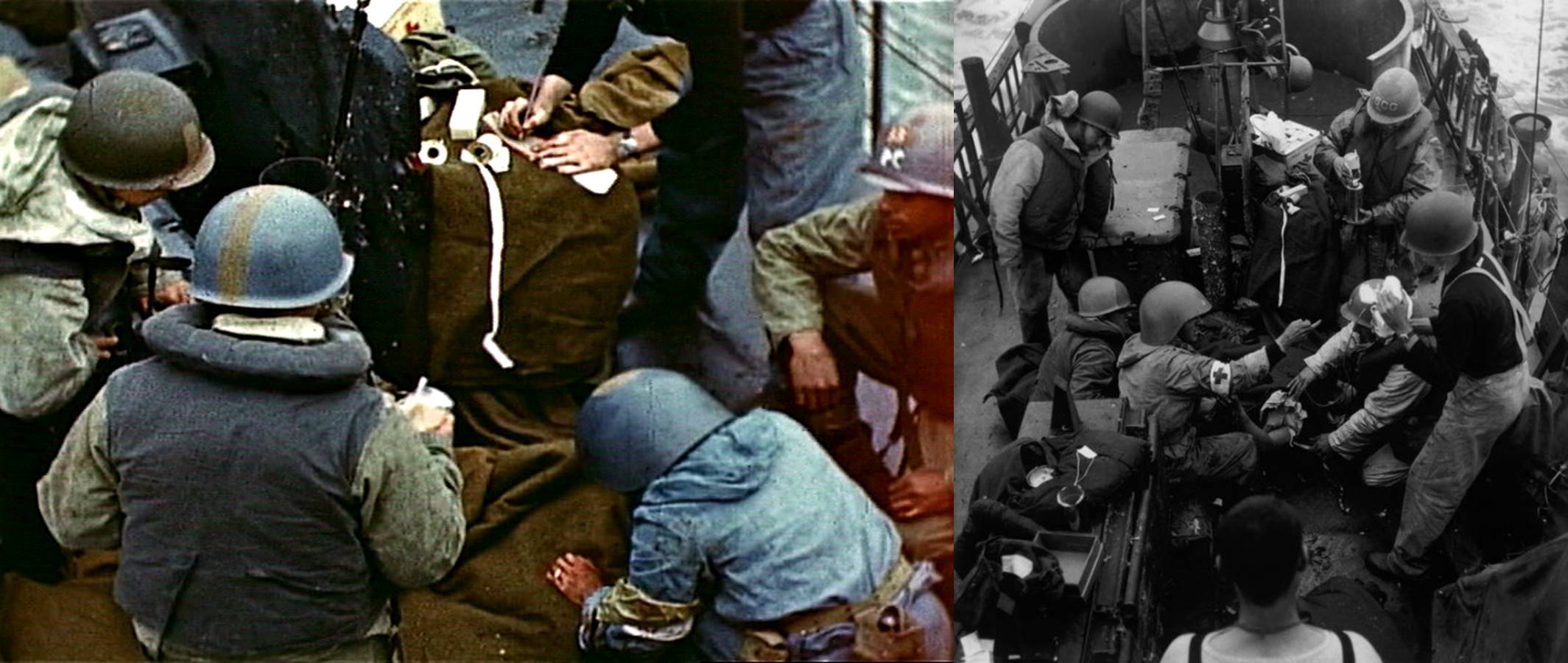
Fig. 22: Medic and crew treating wounded seaman aboard LCI(L)-94, D-Day. Frame from film by David Ruley (l) and photo by Robert Capa (r).
Capa could not resist embellishing this simple sequence of events. As was common for him, he borrowed details from — or simply inserted himself into — scenes others had experienced. So he saw the kapok debris field and made himself a victim of it. He saw the sailors struggling to transfer a stretcher down to an LCVP, and he inserted himself into the process, exaggerating both his role and the number of stretchers. And of course, having seen LCI(L)-85 limping along in sinking condition, he appropriated those details for his account of his own ship.
•
And that, I believe is the most likely scenario that can be sifted out of Capa’s vague and conflicting narratives. I won’t claim this scenario is correct in all its details. It is, after all, a result of balancing well-established facts with a great number of accounts that are partly accurate, partly doubtful, and sometimes plainly wrong. Nevertheless, I suggest that it is the most likely sequence of events as we understand the facts today. …
Notes:
[1] The point where the LCVP is beached in Figure 9 was one of the very few gaps on Omaha Beach at that time. As a result, it saw a continuous series of landing craft beach there. Capa’s negatives 35 and 36 show three LCVPs waiting close offshore for a chance to enter that gap, and it is also the spot at which LCI(L)-94 chose to beach the second time.
[2] The negative for Capa’s “Face in the Surf” is lost, so we have no proof what frame it was in his role of film. Surviving negatives range from 29 to 38, with negative 37 missing, so it is logically assumed that the “Face in the Surf” came from that missing negative. If so, Capa took just one more photo after noticing the arrival of LCI(L)-94 through his viewfinder.
•
Text copyright © 2023 by Charles Herrick. All rights reserved.
•
(For an index of links to all posts in this series, click here.)
•
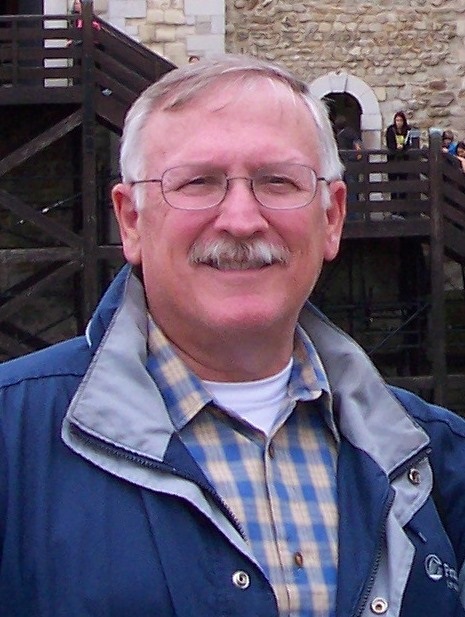 Charles Herrick joined the U.S. Army in 1970 and graduated from the U.S. Military Academy at West Point in 1974. Commissioned in the Infantry, he earned the Ranger tab and Master Parachutist’s wings. He served in a variety of positions from company grade officer to the Pentagon. He earned the Combat Infantryman’s badge while assigned as the Operations Officer of the 193rd Infantry Brigade in Panama in 1989, and later graduated from the U.S. Army War College.
Charles Herrick joined the U.S. Army in 1970 and graduated from the U.S. Military Academy at West Point in 1974. Commissioned in the Infantry, he earned the Ranger tab and Master Parachutist’s wings. He served in a variety of positions from company grade officer to the Pentagon. He earned the Combat Infantryman’s badge while assigned as the Operations Officer of the 193rd Infantry Brigade in Panama in 1989, and later graduated from the U.S. Army War College.
Since retiring from the Army in 1996, Herrick has continued to work on defense issues as a contractor in East Asia, Latin America, the Balkans, Africa and Central Asia. He holds an MBA from the University of California at Los Angeles. He lives in California with his wife, where he pursues his passion for military history. To contact Charles Herrick, click here.






Leave a Comment